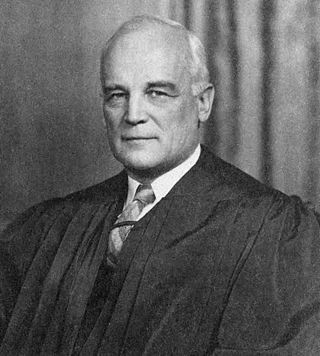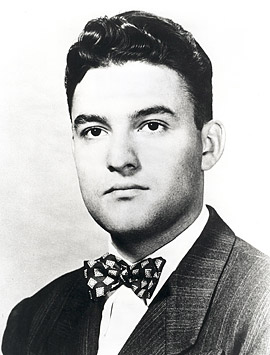Related Research Articles
Brown v. Board of Education of Topeka, 347 U.S. 483 (1954), was a landmark decision by the U.S. Supreme Court which ruled that U.S. state laws establishing racial segregation in public schools are unconstitutional, even if the segregated schools are otherwise equal in quality. The decision partially overruled the Court's 1896 decision Plessy v. Ferguson, which had held that racial segregation laws did not violate the U.S. Constitution as long as the facilities for each race were equal in quality, a doctrine that had come to be known as "separate but equal". The Court's decision in Brown paved the way for integration and was a major victory of the civil rights movement, and a model for many future impact litigation cases.
Separate but equal was a legal doctrine in United States constitutional law, according to which racial segregation did not necessarily violate the Fourteenth Amendment to the United States Constitution, which nominally guaranteed "equal protection" under the law to all people. Under the doctrine, as long as the facilities provided to each "race" were equal, state and local governments could require that services, facilities, public accommodations, housing, medical care, education, employment, and transportation be segregated by "race", which was already the case throughout the states of the former Confederacy. The phrase was derived from a Louisiana law of 1890, although the law actually used the phrase "equal but separate".

Harold Hitz Burton was an American politician and lawyer. He served as the 45th mayor of Cleveland, Ohio, as a U.S. Senator from Ohio, and as an associate justice of the Supreme Court of the United States.
Briggs v. Elliott, 342 U.S. 350 (1952), on appeal from the U.S. District Court for the Eastern District of South Carolina, challenged school segregation in Summerton, South Carolina. It was the first of the five cases combined into Brown v. Board of Education (1954), the famous case in which the U.S. Supreme Court declared racial segregation in public schools to be unconstitutional by violating the Fourteenth Amendment's Equal Protection Clause. Following the Brown decision, the district court issued a decree that struck down the school segregation law in South Carolina as unconstitutional and required the state's schools to integrate. Harry and Eliza Briggs, Reverend Joseph A. DeLaine, and Levi Pearson were awarded Congressional Gold Medals posthumously in 2003.

Gebhart v. Belton, 33 Del. Ch. 144, 87 A.2d 862, aff'd, 91 A.2d 137, was a case decided by the Delaware Court of Chancery in 1952 and affirmed by the Delaware Supreme Court in the same year. Gebhart was one of the five cases combined into Brown v. Board of Education, the 1954 decision of the United States Supreme Court which found unconstitutional racial segregation in United States public schools.
Oliver Leon Brown was an African-American welder who was the plaintiff in the landmark 1954 U.S. Supreme Court case Oliver Brown, et al. v. Board of Education of Topeka, et al. He was recruited to be part of the Topeka NAACP legal action to desegregate the city's public elementary schools in 1950. At the time, Brown was a welder for the Atchison, Topeka and Santa Fe Railway and was studying to become a minister. Attorney Charles Scott, who was his childhood friend, asked him to join the roster of parents who would become plaintiffs in the organization’s case against the Topeka Board of Education.
Education in Kansas is governed at the primary and secondary school level by the Kansas State Board of Education. The state's public colleges and universities are supervised by the Kansas Board of Regents.
Brown v. Board of Education National Historical Park was established in Topeka, Kansas, on October 26, 1992, by the United States Congress to commemorate the landmark decision of the U.S. Supreme Court in the case Brown v. Board of Education aimed at ending racial segregation in public schools. On May 17, 1954, the Supreme Court unanimously declared that "separate educational facilities are inherently unequal" and, as such, violated the 14th Amendment to the United States Constitution, which guarantees all citizens "equal protection of the laws."

Phillip D. Kline is a former American attorney who served as a Kansas state legislator, district attorney of Johnson County, and Kansas Attorney General. Kline, a member of the Republican Party, lost re-election as attorney general to Democratic challenger Paul J. Morrison in 2006. Kline was appointed by the Republican County Central Committee to fill the vacancy left Morrison's election as Kansas Attorney General, becoming district attorney of Johnson County on the day he left office as attorney general and essentially switching jobs with Morrison. Kline then ran for a full term as district attorney, but was defeated in the 2008 Republican primary.

The Warren Court was the period in the history of the Supreme Court of the United States during which Earl Warren served as Chief Justice. Warren replaced the deceased Fred M. Vinson as Chief Justice in 1953, and Warren remained in office until he retired in 1969, at which point he was replaced by Warren Burger. The Warren Court is often considered the most liberal court in US history.

Jack Greenberg was an American attorney and legal scholar. He was the Director-Counsel of the NAACP Legal Defense Fund from 1961 to 1984, succeeding Thurgood Marshall. He was involved in numerous crucial cases, including Brown v. Board of Education, which ended segregation in public schools. In all, he argued 40 civil rights cases before the U.S. Supreme Court, and won almost all of them.

The United States Reports are the official record of the Supreme Court of the United States. They include rulings, orders, case tables, in alphabetical order both by the name of the petitioner and by the name of the respondent, and other proceedings. United States Reports, once printed and bound, are the final version of court opinions and cannot be changed. Opinions of the court in each case are prepended with a headnote prepared by the Reporter of Decisions, and any concurring or dissenting opinions are published sequentially. The Court's Publication Office oversees the binding and publication of the volumes of United States Reports, although the actual printing, binding, and publication are performed by private firms under contract with the United States Government Publishing Office.
Missouri ex rel. Gaines v. Canada, 305 U.S. 337 (1938), was a United States Supreme Court decision holding that states which provided a school to white students had to provide in-state education to Black students as well. States could satisfy this requirement by allowing Black and white students to attend the same school or creating a second school for Black students.

Eric S. Rosen is a justice of the Kansas Supreme Court. He was appointed to the court by Governor Kathleen Sebelius in 2005.
Zelma Henderson was the last surviving plaintiff in the 1954 landmark federal school desegregation case, Brown v. Board of Education. The case outlawed segregation nationwide in all of the United States' public schools. The ruling served as a harbinger of the American Civil Rights Movement and paved the way for the Civil Rights Act of 1964, which outlawed segregation in all public facilities.
Charles D. McAtee was a Marine Corps officer, FBI agent, director of Kansas prisons, attorney, and Republican candidate for both Congress and Kansas Attorney General.
Monroe Gunn McKay was a United States circuit judge of the United States Court of Appeals for the Tenth Circuit.
William A. Smith was a justice of the Kansas Supreme Court from December 1, 1930, to March 1, 1956, and chief justice from March 1, 1956 to January 3, 1957.

Lucinda Todd was an African-American teacher and education activist.

Linda Carol Brown was an American campaigner for equality in education. As a school-girl in 1954, Brown became the center of the landmark United States civil rights case Brown v. Board of Education. Brown was in third grade at the time, and sought to enroll at Sumner School in Topeka, Kansas. Her admission was denied based on her race. Her lawsuit against segregation in elementary schools was ultimately successful and the resulting Supreme Court precedent overturned the 'separate but equal' doctrine which had been previously established in Plessy v. Ferguson. Brown became an educator and civil rights advocate.
References
- A Time to Lose: Representing Kansas in Brown v. Board of Education by Paul E. Wilson (Kansas: 1995)
- Reporting Civil Rights, Part One: American Journalism 1941-1963 (Library of America) by Clayborne Carson, David J. Garrow, Bill Kovach, Carol Polsgrove